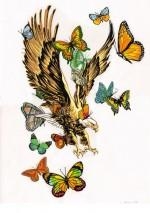Jim Hodges
Based in New York, Jim Hodges came to prominence in the 1990s with work that explores the complex themes of love, loss, beauty, nature and relationships. Often directly autobiographical, the work invites an intimacy with the viewer in which personal detail is expressed without being circumscribed, allowing us to relate to the universal relevance of emotional experiences such as sadness, joy or grief.
Hodges creates his fragile works from both everyday and precious materials: gold leaf and silver chain; paper napkins and artificial flowers. The exhibition will include a number of works on paper: whether using saliva to transfer an ink drawing to paper, or delineating form with folds, sutures, pierced and torn surfaces, these intimate works are viscerally evocative of the contingency of the human body. Employing time-consuming and repetitive techniques, Hodges’ work is intricately crafted; spiders’ webs are spun from silver chain and photographs of trees have each individual leaf carefully traced and cut out.
To create A Diary of Flowers (1994), Hodges spent three years drawing on paper napkins from his daily trips to delis and restaurants, creating a delicate tableau of intricate still-lifes. The works in gallery 3 are brought together in part as a response to an exhibition held in the same space by his friend and sometime collaborator Felix Gonzales Torres in 1994, will include a large wall painting, Oh Great Terrain. Based upon a camouflage pattern, the multi-layered interpretations comprise the loss of individual identity, political associations including its military function, as well as the original work of Abbott Thayer and Andy Warhol’s camouflage series. The exhibition is organised by the Centre Pompidou, Musée national d'art moderne, Paris, in collaboration with Fondazione Bevilacqua La Masa, Venice and Camden Arts Centre, London.

Recommended for you
Based in New York, Jim Hodges came to prominence in the 1990s with work that explores the complex themes of love, loss, beauty, nature and relationships. Often directly autobiographical, the work invites an intimacy with the viewer in which personal detail is expressed without being circumscribed, allowing us to relate to the universal relevance of emotional experiences such as sadness, joy or grief.
Hodges creates his fragile works from both everyday and precious materials: gold leaf and silver chain; paper napkins and artificial flowers. The exhibition will include a number of works on paper: whether using saliva to transfer an ink drawing to paper, or delineating form with folds, sutures, pierced and torn surfaces, these intimate works are viscerally evocative of the contingency of the human body. Employing time-consuming and repetitive techniques, Hodges’ work is intricately crafted; spiders’ webs are spun from silver chain and photographs of trees have each individual leaf carefully traced and cut out.
To create A Diary of Flowers (1994), Hodges spent three years drawing on paper napkins from his daily trips to delis and restaurants, creating a delicate tableau of intricate still-lifes. The works in gallery 3 are brought together in part as a response to an exhibition held in the same space by his friend and sometime collaborator Felix Gonzales Torres in 1994, will include a large wall painting, Oh Great Terrain. Based upon a camouflage pattern, the multi-layered interpretations comprise the loss of individual identity, political associations including its military function, as well as the original work of Abbott Thayer and Andy Warhol’s camouflage series. The exhibition is organised by the Centre Pompidou, Musée national d'art moderne, Paris, in collaboration with Fondazione Bevilacqua La Masa, Venice and Camden Arts Centre, London.

 ARTISTS
ARTISTS













